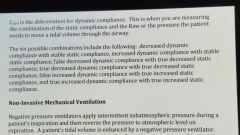![]()
![]()
![]()
Use LEFT and RIGHT arrow keys to navigate between flashcards;
Use UP and DOWN arrow keys to flip the card;
H to show hint;
A reads text to speech;
14 Cards in this Set
- Front
- Back
- 3rd side (hint)
|
PCV |
Press control ventilation- uses press-controlled breaths preset. Used with infants and ARDS pt's who require high peak inspratory press. |
|
|
|
Indicators for Mechanical Ventilation |
hypotension, acute lung injury, neuromuscular disease, or COPD. An Inspiratory press less than -20cmh2o or a vital capacity less than 1.0L. |
|
|
|
Indicators cont. |
ABG showing persistent hypoxemia, a vital capacity of less than 15mL per kg, or min ventilation of less than 10L per min. |
Pg. 42 |
|
|
Resp and Peak flow rate |
Controlled ventilation RR is set to the total number of vent breaths the pt is given. Assist control the RR is set at the minimum number of breaths for the pt. But the pt may take more breaths. |
Intermittent Mandatory Ventilation: RR is the total number of vent breaths per min, but it is set so the pt may breath on their own between vent breaths. Norm setting is at 10-15 bpm. |
|
|
Peak Inspratory Flow |
Peak flow rate is the setting that determines how fast each breath will be conveyed to the pt. If the flow is not enough to meet the pt"s flow demands, his WOB will increase significantly. Optimal inspiratory flow time is .5-1.5 sec. and an be achieved with a peak inspratory flow rate of 40-70L per min. |
|
|
|
Trigger sensitivity |
Amount of effort a patient must make to cause a vent to deliver a VT breath. Gen set at -1 to -2 cm H2O |
|
|
|
Low Exhaled Vol alarm |
Alerts the RT when a pt has not exhaled a sufficient Vt. Setting at 100ml. |
|
|
|
Low Inspiratory Press alarm |
Alerts RT when the peak airway press is less the vents setting. Setting should be 10-15 cm H2O. |
|
|
|
High Inspiratory Press alarm |
Alerts the RT when a pt peak airway press is equal to or greater than the set press limit. Setting should be 15-20 cm above the pt's PIP. |
|
|
|
Apnea alarm |
No inspiration. Setting should be 15-20 sec. |
|
|
|
High Respiratory Rate alarm |
Alerts RT when the pt is becoming tachynpeic. Setting should be 10-15 breathes per min. |
|
|
|
Calc. Airway Resistance |
Raw = peak airway press - plateau÷flow in L/sec. |
|
|
|
Calc. Cst ( Static compliance) When measuring the ability of the lung to distend. |
Determine by calc. The compliance factor of the breathing circuit: divide the Vt by the peak press. |
|
|
|
Cdyn ( dynamic compl.) Measuring the combination of the static compl and Raw. |

|
|

